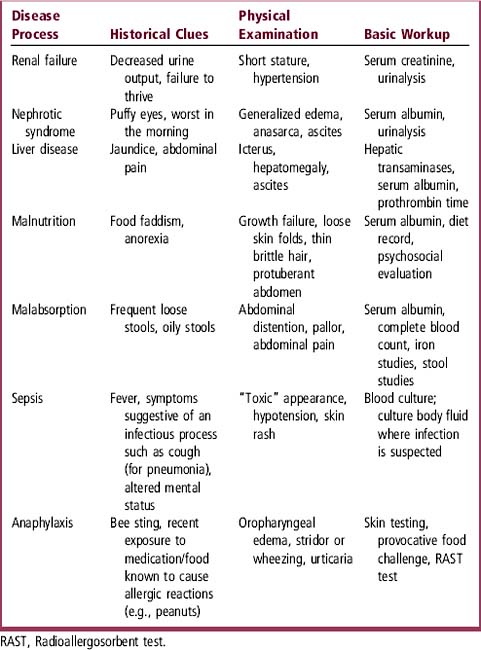Chapter 45 Edema
ETIOLOGY
What Causes Edema?
Three basic mechanisms cause generalized edema:
1 Increased hydrostatic pressure, which forces fluid from the intravascular space into the extravascular space (e.g., congestive heart failure, constrictive pericarditis, and acute or chronic renal failure).
2 Decreased oncotic pressure resulting from hypoalbuminemia, which promotes the movement of fluid into the extravascular tissues because of diminished protein binding within the vascular space (e.g., hepatic failure, nephrotic syndrome, protein malnutrition, hypercatabolic state, and malabsorption syndromes).
3 Increased capillary permeability, which allows fluid to “leak” into extravascular tissues (e.g., capillary endothelial damage because of endotoxemia in the sepsis syndrome).
EVALUATION
How Can I Evaluate a Child with Edema?
Some clues from the history and physical examination that point toward the cause of edema, and the suggested basic initial laboratory workup for these conditions, are presented in Table 45-1. For more details on the specific disease processes, refer to the appropriate sections elsewhere in the text.
Where Might I Find Edema on Physical Examination?
 Visible abdominal distention with bulging flanks
Visible abdominal distention with bulging flanks
 Stretching of the umbilicus in the horizontal direction or bulging of an umbilical hernia
Stretching of the umbilicus in the horizontal direction or bulging of an umbilical hernia
 Dullness to percussion in the flanks when supine; the dullness resolves when the patient rolls to the lateral position (shifting dullness)
Dullness to percussion in the flanks when supine; the dullness resolves when the patient rolls to the lateral position (shifting dullness)
 Fluid wave (place one hand on the flank and tap sharply on the other flank)
Fluid wave (place one hand on the flank and tap sharply on the other flank)
Stay updated, free articles. Join our Telegram channel

Full access? Get Clinical Tree



